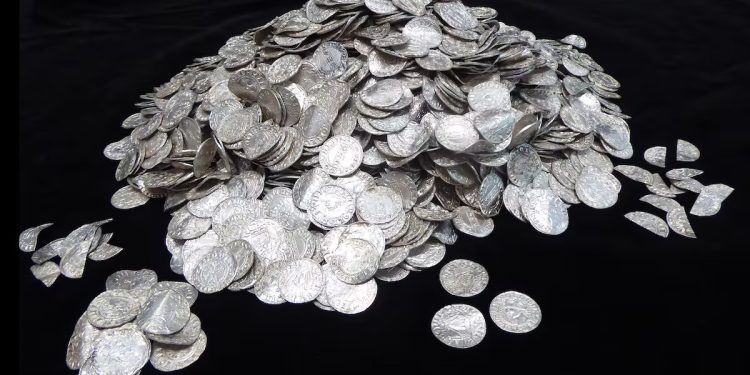In January 2019, a group of amateur treasure hunters made an extraordinary discovery in the rain-soaked fields of southwest England. What began as a casual day of metal detecting turned into one of the most significant archaeological finds in British history. The Chew Valley hoard, consisting of 2,584 silver coins, provides an invaluable glimpse into a pivotal moment during England’s transition from Saxon to Norman rule.
A Chance Discovery Leads to a Historic Find
This Article Includes [hide]
On a typical winter’s day in the Chew Valley, a small group of friends set out to try their luck with a metal detector. They never expected their efforts would lead them to unearth a treasure that would captivate historians and collectors alike. The coins, all dating back to the 11th century, were buried deep underground—preserved for nearly 1,000 years.
What started with one coin quickly escalated into a remarkable collection. By the end of their search, the group had recovered 2,584 silver coins, all minted between 1066 and 1068, during a time of significant upheaval in England.
Historical Significance of the Chew Valley Hoard
The Chew Valley hoard represents a unique snapshot of England’s history during the Norman Conquest, one of the most transformative periods in the country’s past. The coins feature the likenesses of three rulers: William I, known as William the Conqueror, Harold II, the last Saxon king, and Edward the Confessor, the former king who ruled just before Harold II.
These coins not only provide a link to the rulers of the time but also offer insight into the turbulent events of 1066, when William of Normandy defeated Harold II at the Battle of Hastings. This victory led to the Norman Conquest, which forever changed English society, law, culture, and even the language. The coins found in the hoard are believed to have been buried around 1067 or 1068, possibly for safekeeping during a period of rebellion against the newly established Norman regime.
The Financial Reward for the Finders
The value of the Chew Valley hoard has been assessed at a staggering £4.3 million ($5.6 million). Following a landmark agreement, half of the proceeds from the sale will go to the group of treasure hunters who made the discovery, while the other half will be allocated to the owner of the land where the coins were found.
This deal is made possible by the Treasure Act of 1996, which allows individuals who find historically significant objects to receive a share of the proceeds when the items are sold to museums or collectors. The Chew Valley hoard is one of the largest and most valuable finds to come under this legislation.
A Legacy for Future Generations
Thanks to a successful acquisition by the South West Heritage Trust, the coins will be preserved for future generations. The hoard will first be displayed at the British Museum in London before traveling to other museums across the United Kingdom. Eventually, the collection will be permanently housed at the Museum of Somerset, allowing people throughout the country to witness and learn from this extraordinary piece of history.
The acquisition of the hoard has been hailed as a significant step in preserving England’s cultural heritage. It offers a unique opportunity for the public to learn more about the Norman Conquest and the 11th century, a period that defined much of modern England.
The Role of Modern Technology in Treasure Hunting
The discovery of the Chew Valley hoard also highlights the role of modern metal detection technology in uncovering hidden treasures. While treasure hunting is a popular hobby in the UK, advancements in metal detectors have made it easier than ever to locate historical artifacts buried beneath the soil. The rise of “dirt fishing” has led to an increasing number of finds being reported, with 1,378 treasure discoveries reported in England, Wales, and Northern Ireland in 2022 alone.
The Chew Valley hoard represents not only an important historical discovery but also a perfect example of how modern technology has enhanced our ability to uncover the secrets of the past.
Conclusion: A Treasure for the Ages
The Chew Valley hoard stands as one of the most remarkable finds in British history, offering a direct link to the Norman Conquest and the bloody struggles that defined England’s transition from Saxon to Norman rule. The hoard’s discovery has captivated the public’s imagination and will continue to inspire future generations as it is displayed across the UK. With its historical significance, immense value, and the story of its discovery, the Chew Valley hoard is a treasure for the ages.
Also Read:
- What is the typical ‘upper-class’ retirement nest egg? Here’s A Look At What The Wealthiest 20% Have Stacked Away
- 30 Creative Ways to Make Money Working From Home


